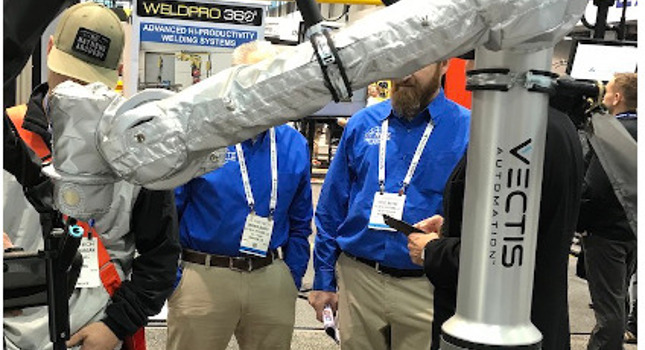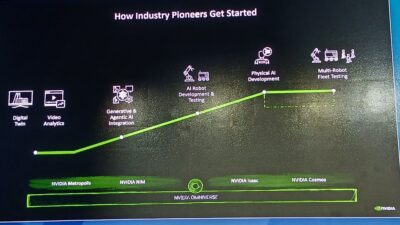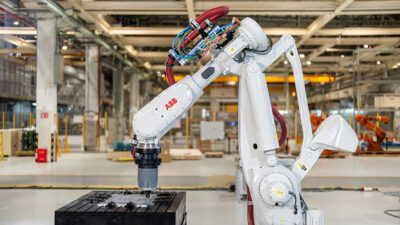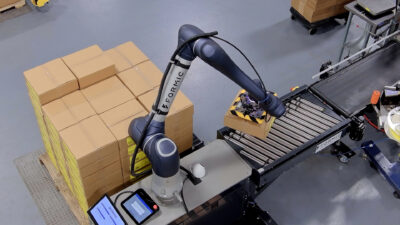The changes to robots and robotic products, along with their growing presence, makes it important to understand potential hazards associated with these devices.

The market for robots and robotics is seeing significant growth, with expectations for a compound annual growth rate (CAGR) of more than 25% in the first half of the 2020’s. The field of robotics has evolved to include a variety of devices, such as collaborative robots, autonomous mobile robots (AMRs), industrial mobile robots (IMRs), automatic guided vehicles (AGVs), and robotic personal assistants. These robots differ greatly from the robots seen in the past. They may be mobile, interact with people more directly, are more engaging, and, as with many types of products, are influenced by technological advancements, connectivity and increased autonomy.
The changes to robots and robotic products, coupled with their continued growth and increased presence, makes it important to understand potential hazards associated with these devices. Beyond that, it is critical to understand the standards and testing options manufacturers and developers should use to mitigate risk and illustrate safety and regulatory compliance.
Classifying potential robot risks and hazards
Per ISO 8373, a robot is defined as an activated mechanism programmable in two or more axes with a degree of autonomy, moving within its environment, to perform intended tasks. Of course, they can be more complex than this. They entail risks that must be accounted for when creating and working with robots. The following are common hazards for most types of robots:
- Mechanical: Issues related to the design and function of the system itself must be considered and assessed.
- Electrical: The overall safety and performance of electrical components within the device and the device itself must be considered, particularly to electrical safety standards.
- Electromagnetic Interference (EMI): Issues arising from electromagnetic fields emanating from the devices to other electrical products or to the device from other products in the area.
- Ergonomic: Potential concerns related to the design and comfort of the device or system.
- Thermal: Products muse be assessed for the potential to overheat, which could result in fire, burns or other damage
- Acoustical/noise: Operational issues resulting in unwanted or loud noises could arise as a product performs it given task or function
- Vibration: Mechanical issues that, during use, lead to unwanted or excessive vibration. This, in turn, can produce noise and potential damage to the product.
- Radiation: Electromagnetic emissions from the system and its components must fall within a range that is considered safe and acceptable.
- Material/substance: Hazards related to the components within the robot, such as wiring, metals, software, etc.
- Environmental: Hazards associated with the specific environment related the machine’s intended use. For example, in a healthcare environment, potential hazards associated with other medical devices and their critical functions.
- Battery: Concerns related to charging, overheating, fire, or spark in devices that use batteries and/or energy storage components.
Hazards and required safety measures depend on the type of application/intended use, since robots and robotic systems come in different shapes and sizes and are used in different applications. Some hazard combinations may occur, such as vibration/noise, electrical/thermal or electrical/radiation/EMI. Keep potential combinations in mind when developing products, so you can mitigate risk and test appropriately when assessing the device.
Risk assessment for each defined hazard is needed to determine suitable risk reduction measures. If a hazard cannot be eliminated through inherently safe design, appropriate safeguarding and other protective measures are required. Risk assessments should be done at each development stage.
Robot hazard tests
To assess the hazards associated with robotics, there are several testing options that may be used, depending on the hazard(s), identified in your device. These include, but are not limited to:
- Hazardous locations assessments for products used in hazardous locations or explosive atmospheres, to specific requirements.
- Functional safety evaluations to ensure fail-safe mechanisms are operating correctly.
- Mechanical assessments for potential risks and mitigation measures.
- Electrical safety testing to make sure safe operation related to electricity use, and to illustrate compliance to required electrical safety standards.
- Battery/charger evaluations to ensure energy storage technologies meet performance, reliability and safety criteria.
- Performance testing to gage characteristics like grip, cameras, vibration, and acoustics for overall performance and consistency over time.
- Process evaluations, which includes risk management, programmable electrical medical systems, and usability, depending on individual products, intended use and environment.
- Environmental testing to assess hazards and performance related to a device’s intended environment.
- Electromagnetic compatibility (EMC) to help to confirm EMI mitigation.
- Wireless and cybersecurity testing, to confirm applicable systems meet requirements for connectivity, function, and data protection.
It is important to note hazards and their respective tests to assess them are often covered by applicable safety standards, so knowledge and understanding of these standards are important.
Robot standards and regulations
Regulatory requirements for robots vary by market and industry, so it is important to know which standards apply to a given project. The ISO 10218-1 and ISO 10218-2 standards address safety requirements for industrial robots, systems, and integration, and have been harmonized and adopted by many countries and regions. However, depending on the market and application, there are other standards that may apply.
Europe
Robots in the EU are regulated based on application. Manufacturers should follow existing EN and ISO standards on robotic devices; several are harmonized under the Machinery Directive. This will ensure the safety of the robot, based on the outcome of their product risk assessment, which starts with the definition of intended use, reasonably foreseeable misuse / machinery limits and the hazard identification. Applicable European standards include, but are not limited to:
- EN ISO 10218-1 and 10218-2, covering safety requirements for industrial robots, robot systems and integration
- EN 12100, which includes general principles for design, risk assessment, and risk reduction for machinery
- ISO/TS 15066, specific to collaborative robots
- EN 61000-6-2 and 61000-6-4, which focuses on EMC immunity and emissions for industrial environments
- ATEX Directive 2014/34/EU for robots used in hazardous locations or potentially explosive environments
- EN 13857 for robots used in hazardous locations/potentially explosive environments, if the safety of machinery is governed by safety distance
- Radio Equipment Directive (RED), which establishes safety and EMC requirements for equipment using the radio spectrum.
North America
In the Us and Canada, standards have been developed for robots and robotic devices, along with existing international standards. These include 10218-1 and 10218-2 and harmonized standards ANSI/RIA R15.06 and R15.08 and CAN/CSA Z434, as well as:
- ANSI/UL 1740 for robots and robotic equipment
- IEC 61508-1, 61508-2, and 61508-3 for the functional safety of electrical, electronic, and programmable electronic safety-related systems and their software
- IEC 62061 for functional safety of safety-related electrical, electronic, and programmable electronic control systems
Asia
In Asia, many countries and regions have robotics standards harmonized with ISO 10218-1. These include GB 11291 and 11291.2-2013 in China, JIS 8433-1 in Japan, KS B ISO 10218-1 and 10218-2 in South Korea, CNS 14490-1 B8013-1 and 14490-2 B8013-2 in Taiwan, and SS ISO 10218-1:2016 and 10218-2:2016 in Singapore. Additional standards exist to cover risk management, including assessment and reduction, such as GB/T 15706-2012 in China and JIS B9700:2013 in Japan. Finally, standards for collaborative robots must be considered in Japan under JIS TS B0033.
Robot best practices
Manufacturers and developers can prepare their products for various markets in several ways. First, know the standards and requirements for the market you are looking to enter, and stay informed on inevitable updates and changes. Similarly, stay current on changes in technology and applications, as they may impact standards and requirements. Identify any overlaps to the testing and assessment requirements of the market(s) you wish to enter. This may help streamline your approach, which, in turn, can get products to market more quickly and at a reduced cost.
Perform a risk analysis for hazards and determine proper testing and assessment to address them, as well as corrective actions. Work with a trusted and knowledgeable partner who knows the standard and best ways to illustrate compliance. They can help build a comprehensive test plan to get products to market, a plan that includes assessments for quality and safety to help ensure a product’s success.
Robots and robotics offer many possibilities to so many different industries and many manufacturers wish to explore the opportunities with these products. Knowing the standards and requirements can not only ensure a safer, better performing product, it can allow you to get your products to market quickly and efficiently.
Pierrick Balaire, global business line director at Intertek, a CFE Media content partner. Edited by Chris Vavra, web content manager, Control Engineering, CFE Media and Technology, [email protected].
REFERENCES
Mordor Intelligence. “Robotics Market – Growth, Trends, and Forecasts (2020 – 2025).” https://www.mordorintelligence.com/industry-reports/robotics-market.



